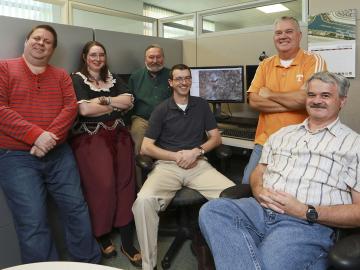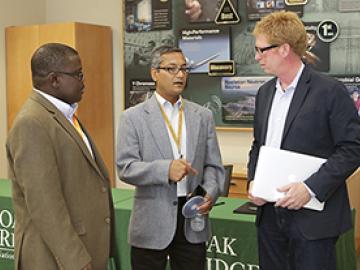
Filter News
Area of Research
- (-) Fuel Cycle Science and Technology (3)
- (-) Geographic Information Science and Technology (3)
- (-) Materials for Computing (36)
- Advanced Manufacturing (34)
- Biological Systems (18)
- Biology and Environment (177)
- Biology and Soft Matter (5)
- Building Technologies (12)
- Chemical and Engineering Materials (4)
- Chemistry and Physics at Interfaces (11)
- Clean Energy (522)
- Climate and Environmental Systems (14)
- Computational Biology (6)
- Computational Chemistry (5)
- Computational Engineering (5)
- Computer Science (19)
- Data (1)
- Earth Sciences (1)
- Electricity and Smart Grid (3)
- Energy Frontier Research Centers (14)
- Energy Sciences (5)
- Fossil Energy (3)
- Functional Materials for Energy (16)
- Fusion and Fission (54)
- Fusion Energy (17)
- Isotope Development and Production (3)
- Isotopes (35)
- Materials (433)
- Materials Characterization (2)
- Materials Synthesis from Atoms to Systems (13)
- Materials Under Extremes (12)
- Mathematics (1)
- National Security (80)
- Neutron Data Analysis and Visualization (4)
- Neutron Science (190)
- Nuclear Science and Technology (74)
- Nuclear Systems Modeling, Simulation and Validation (3)
- Nuclear Systems Technology (1)
- Quantum Condensed Matter (4)
- Quantum information Science (9)
- Reactor Technology (1)
- Renewable Energy (4)
- Sensors and Controls (5)
- Supercomputing (311)
- Transportation Systems (11)
News Topics
- 3-D Printing/Advanced Manufacturing (4)
- Bioenergy (1)
- Biology (1)
- Biomedical (2)
- Chemical Sciences (4)
- Climate Change (1)
- Composites (1)
- Computer Science (7)
- Coronavirus (3)
- Decarbonization (1)
- Energy Storage (4)
- Environment (1)
- Isotopes (1)
- Materials (10)
- Materials Science (15)
- Microscopy (4)
- Nanotechnology (7)
- National Security (2)
- Neutron Science (5)
- Nuclear Energy (1)
- Polymers (6)
- Quantum Computing (1)
- Quantum Science (3)
- Security (1)
- Simulation (1)
- Space Exploration (1)
- Summit (1)
- Sustainable Energy (5)
- Transportation (5)
Media Contacts

The United Kingdom’s National Nuclear Laboratory and the U.S. Department of Energy’s Oak Ridge National Laboratory have agreed to cooperate on a wide range of nuclear energy research and development efforts that leverage both organizations’ unique expertise and capabilities.

Bruce Lester has had a lot of jobs: fisherman, horse trainer, “professional stair builder.” He last worked for a real estate company, surveying land using geographic software. “When the bottom fell out of the construction industry and the company downsized, I got laid off,”







The American Conference on Neutron Scattering returned to Knoxville this week, 12 years after its inaugural meeting there in 2002.

Knoxville-based Fiveworx has licensed an Oak Ridge National Laboratory technology that will help consumers reduce their utility bills by analyzing their home energy usage.


